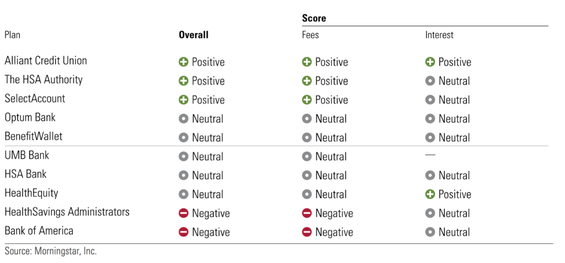We've published new research. Read highlights from our 2019 assessment of HSA providers.
As I wrote in my previous post, there are two main ways to use HSAs: as a spending account for current medical expenses, or as an investment account to save for future medical expenses.
In this post, we’ll look at the best HSA plans to use to pay for current medical charges, which can be a good strategy for some accountholders. HSAs effectively increase the accountholder’s buying power for medical expenses. Since contributions and qualified withdrawals are both tax-free (along with a payroll tax break if contributions are made via payroll deduction, and the accountholder earns less than $127,200), the accountholder’s dollars are stretched further than they otherwise would be if they were just paying out of pocket. This is particularly beneficial for workers who do not have the resources to pay for all their medical expenses out of pocket and do not plan to invest their HSA assets.
2 factors we used to evaluate HSA plans as spending vehicles
When assessing HSA plans, we examined the plan’s monthly fees and the interest rates. These are the two most important considerations for accountholders planning to use their HSAs primarily as spending vehicles.
- Monthly fees. Accountholders can expect to face a multitude of fees, such as a monthly account maintenance fee, investment fees, and wire transfer fees. While account maintenance fees are not the largest fee assessed on HSAs, they are the most common fee an accountholder can expect to pay. That’s why we focused our assessments on the account maintenance fees. Though they seem small, monthly account maintenance fees can take an outsized bite out of HSA balances. Consider a hypothetical accountholder who contributed $2,000 to her HSA and spent $1,000 of it. The HSA had a $4.50 monthly account maintenance fee, so just over 5% of the accountholder’s ending balance will be paid as monthly account maintenance fees over the course of the year. The best HSA plans offer low or no monthly account maintenance fees to accountholders. We encountered three common monthly account maintenance fee structures when researching HSA plans. Some providers charge a monthly account fee, regardless of deposits. Others charge a monthly fee but offered to waive it if a certain threshold in deposits is crossed. Last, some providers offer HSA plans free of monthly account fees, regardless of balance.
- Interest rates. Although interest rates may be an important consideration in the future, they were not a deciding factor in this report. None of the HSA providers we studied offered an interest rate compelling enough that would tip the scales one way or the other. The average HSA balance is relatively low—about $2,500 in 2016, according to research by the Employee Benefits Research Institute—and so a difference of even a percentage point would likely not make a large enough impact for consideration. Accountholders should not rely on interest rates to generate appreciable returns on their HSA assets.
The best HSA plans to use as spending vehicles
Of the HSAs we studied as spending vehicles, three earned positive assessments, five earned neutral assessments, and two earned negative assessments. Alliant Credit Union, the HSA Authority, and SelectAccount all earned positive marks as they offer HSAs without monthly account maintenance fees. Optum Bank, BenefitWallet, UMB Bank, HSA Bank, and HealthEquity earned neutral assessments. They do charge monthly fees, but offer to waive them once accountholders have accumulated a certain amount. Even though these providers offer to waive fees if the balance is high enough, some accountholders who are using them as spending vehicles might never accumulate enough money to find relief from these fees. Bank of America and HealthSavings Administrators earned negative assessments because they levied monthly fees regardless of deposits.

Accountholders using their HSAs as spending vehicles are best served by plans without monthly maintenance fees. That way, their balances aren’t slowly eaten up by fees, and they can stretch their money set aside for healthcare expenses as far as possible.
In my next post, I’ll take a deeper look at using HSAs as investment vehicles.


